Featured designers and producers
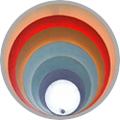 |
 |
 |
 |
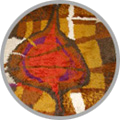 |
 |
|
| Lyfa | Torben Ørskov | Louis Weisdorf | Simon Henningsen | Ege Rya | Jo Hammerborg | Fog & Mørup |
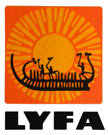 Based in Ballerup in the greater Copenhagen area, Danish lighting company Lyfa began life during the early years of the 20th century as Københavns Lampe Og Lysekronefabrik.
Based in Ballerup in the greater Copenhagen area, Danish lighting company Lyfa began life during the early years of the 20th century as Københavns Lampe Og Lysekronefabrik.
In the 1930s the company abbreviated its name to Lyfa. Its main output during that decade was a range of table lamps closely modelled on Poul Henningsen's revolutionary multi-shade lamp of 1924 for Louis Poulsen, which later became known as the PH lamp.

By the 1950s Lyfa had become a significant innovator in its own right, employing and commissioning many prominent architects and designers to produce high-quality and original lighting which took advantage of new technologies and materials. Throughout the 1950s, 60s and 70s Lyfa's designs were widely acclaimed, regularly featuring in design publications like The Studio magazine and winning many prizes.
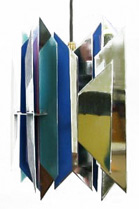 Architects and designers employed or commissioned by Lyfa during its 1950s to 1970s heyday period included Piet Hein, Finn Juhl, Claus Bonderup, Bent Karlby, Louis Weisdorf, Acton Bjørn, Simon Henningsen (the son of PH), Michael Andersen, Klaus Helweg-Larsen, and Nils and Eva Koppel.
Architects and designers employed or commissioned by Lyfa during its 1950s to 1970s heyday period included Piet Hein, Finn Juhl, Claus Bonderup, Bent Karlby, Louis Weisdorf, Acton Bjørn, Simon Henningsen (the son of PH), Michael Andersen, Klaus Helweg-Larsen, and Nils and Eva Koppel.
The lights produced at Lyfa during these decades tend to be of exceptionally high quality. Many of them have sculptural forms, often created through an intricate weaving of strong metal sections, such as the Facet Pop, designed by Louis Weisdorf and pictured bottom left.
 Other examples juxtaposed parallel metal plates at precise distances, with surfaces painted to create specific colour effects such as the impression of a spectrum. These colour effects change as the amount of ambient light increases or decreases, emphasising the lamp's role as an artwork as well as a functional device. Particularly striking examples are the Kvadrille (pictured left), and the Påfugl or Peacock (above left), both designed by Bent Karlby.
Other examples juxtaposed parallel metal plates at precise distances, with surfaces painted to create specific colour effects such as the impression of a spectrum. These colour effects change as the amount of ambient light increases or decreases, emphasising the lamp's role as an artwork as well as a functional device. Particularly striking examples are the Kvadrille (pictured left), and the Påfugl or Peacock (above left), both designed by Bent Karlby.
Multiple brightly coloured surfaces were in themselves a common theme at Lyfa, and can also be seen in Simon Henningsen’s famous Divan 2 light (above right), designed in the 1960s for the Divan 2 restaurant in Copenhagen's Tivoli Gardens.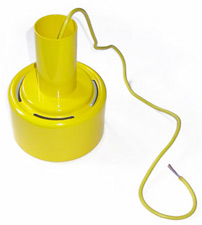
Lyfa won ten iF design awards during the 60s and 70s. These were a 1967 award for Bent Karlby's P523 pendant light, two awards in 1969 for the Glastop ceiling lights by Nils and Eva Koppel, three awards in 1971 for Piet Hein's pendant lights, one award in 1973 for Louis Weisdorf's Turbo II ceiling light and another in 1975 for the Piccolo (right), and two awards in 1978 for Klaus Helweg-Larsen's Varia lights.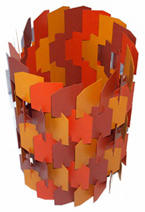
In the late 1970s Lyfa merged with another radical Danish lighting company, Fog & Mørup, and the two companies now shared the factory premises at Ballerup.
At the beginning of the 1980s Lyfa-Fog & Mørup was taken over by by a mass-market lighting producer, Lyskaer, and the Fog & Mørup brand was abandoned. Lyskaer-Lyfa continued to produce lights under the Lyfa label until 1991, when Lyskaer-Lyfa was incorporated into Horn Belysning A/S of Aalstrup. Horn kept the Lyskaer-Lyfa branding active until 1999, when it was subsumed under the Horn Belysning label.
UPDATE May 2019: In 2005 Horn changed its name to Lightyears, and in 2015 Lightyears A/S was incorporated into prestigious Danish cabinetmakers Fritz Hansen.
© 2004 Classic Modern. All rights reserved.
 |
 |
 |
 |
 |
 |
|
| Lyfa | Torben Ørskov | Louis Weisdorf | Simon Henningsen | Ege Rya | Jo Hammerborg | Fog & Mørup |